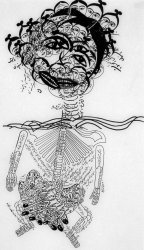b1965
< BACK
Samira Abbassy was born in Ahwaz, south-western Iran in 1965 and identifies herself as being Arabic rather than Persian. In 1967, her family moved to Britain where she was educated from primary school onwards. She studied painting, first at Birmingham Polytechnic and then at Canterbury College of Art.
Abbassy's career was centred on London for most of the 1980s and 1990s, where she established a successful gallery career. She won a painting award at the Royal Academy in 1997, before moving in 1998 to New York where she now lives and works. She has had solo and group shows in New York and in London, where she has exhibited with England & Co.
Visually, Abbassy's work reflects her cross-cultural heritage in a number of ways. She draws on the visual traditions of both Middle Eastern and Western art in a manner that is neither superficial nor eclectic, but rooted firmly in her belonging to both cultures. The recurring themes in her work aim toward a shared mythology and iconography that underlies both societies. She excavates through layers of often-contradictory cultural identity towards an understanding of her own background. Abbassy has said of her recent work that she is attempting 'to reach beyond the language of narrative painting towards the metaphysical'. In some works she has shown figures as if they had been x-rayed, revealing the anatomical and biological reality of their interiors, and leading the viewer to read the figures as 'psychic maps'. A particular reference she has used is a 17th-century Persian manuscript of anatomical drawings said to have been made without the use of dissection and in the belief that the study of the human body could lead to an understanding of the wisdom of God. Abbassy also references the philosophers of the Islamic Enlightenment who evolved a numerical symbolism of parts of the human body that corresponded with various areas of the cosmos, and the political thinkers who used the symbolism of the human anatomy to explain their theories of human society. She has also been drawn to 17th-century Indian Tantric paintings depicting the chakra system, another example of an internal system which incorporates physical and non-physical realities.
Self-portraiture is a strong motif in many of Abbassy's recent works. She says that 'although there are elements of autobiography, the figure should be viewed as an archetype rather than a literal attempt at depicting myself. It's as though I'm depicting myself from the inside out, starting with how it feels to be me, or more to the point, how it feels to be human'. She uses the skirt or clothing that the figure is wearing as a picture plane which also shows (in x-ray mode) the interior that it hides. Sometimes the figure develops into an animal form to become a mythological creature such as a Harpy, although remaining somehow very human.
Abbassy's work was acquired by the British Government Art Collection in 2002 and in 2007 she was awarded a New York Foundation for the Arts (NYFA) fellowship. In recent years, she has been included in several major exhibitions of Middle-Eastern art in the USA, and in 2007 had a solo exhibition at the Anthony Giordano Gallery at Dowling College in New York State: Samira Abbassy: Cultural Convergences. She was recently represented in Iran Inside Out at CAM – Chelsea Art Museum – New York.

Calligraphic self-portrait, 2006.
